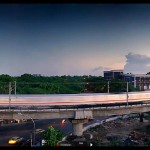The cover story in the latest BusinessWeek! I have come to the conclusion now that, we Indians, have come to believe in our own success and be blinded by it! Little realizing or analysing the problems and issues that are inherent in our situation. Yes, there is a lot of growth… but there are a lot of fissures that are appearing too. Unless we find long term solutions to those, our story may remain just a myth!
When foreigners say Bangalore is India’s version of Silicon Valley, the high-tech office park called Electronics City is what they’re often thinking of. But however much Californians might hate traffic-clogged Route 101, the main drag though the Valley, it has nothing on Hosur Road. This potholed, four-lane stretch of gritty pavement—the primary access to Electronics City—is pure chaos. Cars, trucks, buses, motorcycles, taxis, rickshaws, cows, donkeys, and dogs jostle for every inch of the roadway as horns blare and brakes squeal. Drivers run red lights and jam their vehicles into any available space, paying no mind to pedestrians clustered desperately on median strips like shipwrecked sailors.
Pass through the six-foot-high concrete walls into Electronics City, though, and the loudest sounds you hear are the chirping of birds and the whirr of electric carts that whisk visitors from one steel-and-glass building to the next. Young men and women stroll the manicured pathways that wend their way through the leafy 80-acre spread or coast quietly on bicycles along the smooth asphalt roads.
With virtually no mass transit in Bangalore, Indian technology firm Infosys Technologies Ltd. spends $5 million a year on buses, minivans, and taxis to transport its 18,000 employees to and from Electronics City. And traffic jams mean workers can spend upwards of four hours commuting each day. "India has underinvested in infrastructure for 60 years, and we’re behind what we need by 10 to 12 years," says T.V. Mohandas Pai, director of human resources for Infosys.
India’s high-tech services industry has set the country’s economic flywheel spinning. Growth is running at 9%-plus this year. The likes of Wal-Mart (WMT ), Vodafone (VOD ), and Citigroup (C ) are placing multibillion-dollar bets on the country, lured by its 300 million-strong middle class. In spite of a recent drop, the Bombay stock exchange’s benchmark Sensex index is still up more than 40% since June. Real estate has shot through the roof, with some prices doubling in the past year.
But this economic boom is being built on the shakiest of foundations. Highways, modern bridges, world-class airports, reliable power, and clean water are in desperately short supply. And what’s already there is literally crumbling under the weight of progress. In December, a bridge in eastern India collapsed, killing 34 passengers in a train rumbling underneath. Economic losses from congestion and poor roads alone are as high as $6 billion a year, says Gajendra Haldea, an adviser to the federal Planning Commission.
Powered by Qumana











